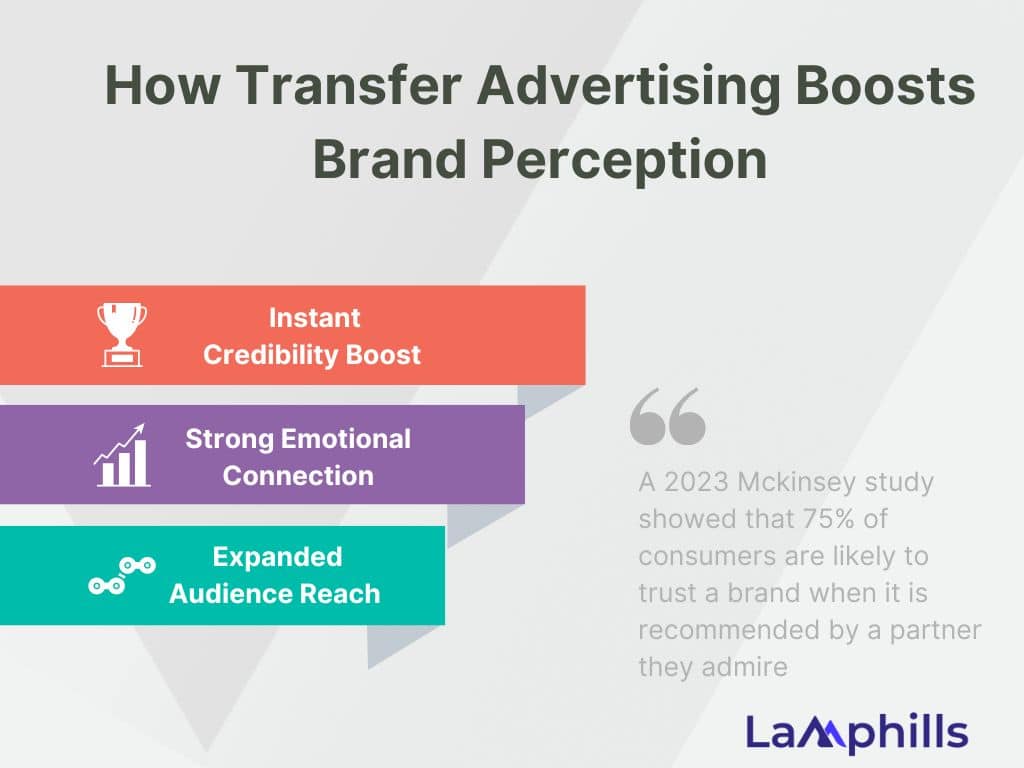I once came across a vlog where the legendary footballer Cristiano Ronaldo talks about drinking mineral water daily. He didn’t mention the brand, but as a digital marketer, I imagined the spike a brand would have enjoyed if he had given us a name. The mentioned brand will leverage the player’s influence to build credibility, and skyrocket sales. This is known as transfer advertising—a strategy that uses the power of association to shift brand perception. Imagine aligning your brand with a trusted name and instantly benefiting from its reputation. This article will walk you through the ins and outs of transfer advertising and show you how to leverage strategic partnerships to boost your brand perception.
Key Points
- Transfer advertising is all about borrowed credibility, in simpler terms, it’s like borrowing someone else’s spotlight to make your brand shine brighter.
- A 2023 McKinsey study showed that 75% of consumers are more likely to trust a brand recommended by a partner they admire.
- The core benefit of transfer advertising is that it builds trust through association.
- It’s one of the most effective ways to build a trustworthy brand in today’s competitive marketplace.
What is Transfer Advertising?
Transfer advertising is all about borrowed credibility. It occurs when one brand partners with another established entity—a well-known company, a trusted celebrity, or an influential figure. Whichever one you decide to go for, it must be something or someone people know, love, or respect. Generally, this creates a “halo effect,” where the positive attributes of the partner brand are transferred to your brand. In simpler terms, it’s like borrowing someone else’s spotlight to make your brand shine brighter.
Understanding Transfer Advertising
I’ve seen firsthand how powerful this strategy can be. The right partner can help you break into new markets, enhance your brand image, and even change public perception almost overnight.
Take Nike, for instance, whose collaborations with athletes like Michael Jordan and Serena Williams have made their products synonymous with success and performance. The partnership transferred the athletic prowess of these stars, enabling Nike to solidify its reputation as the go-to brand for high achievers.
How Transfer Advertising Boosts Brand Perception

A 2023 McKinsey study showed that 75% of consumers are more likely to trust a brand when it is recommended by a partner they admire. This makes transfer advertising one of the most effective ways to build a trustworthy brand in today’s competitive marketplace. The core benefit of transfer advertising is that it builds trust through association. Let’s break down how this works in practice:
#1. Instant Credibility Boost
When your brand partners with a respected entity, consumers naturally extend your partner’s trust to you. According to a recent study by Edelman, 81% of consumers say they need to trust a brand to make a purchase. So if you’re trying to grow your brand, partner with a trusted name, to benefit from their established credibility.
#2. Strong Emotional Connection
When people feel connected to a brand emotionally, they’re more likely to become loyal customers. Therefore, associating with a partner who resonates emotionally with your audience, gives you access to deep connections. Think of how Dove’s “Real Beauty” campaign, in partnership with real women, transferred authenticity and empowerment to their brand image.
#3. Expanded Audience Reach
Partnering with popular brands gives you access to their audience. These are people who were not with your products or services. For example, when Adidas partnered with Kanye West to launch the Yeezy line, it didn’t just reach sneakerheads—it tapped into an entirely new demographic of fashion-forward consumers.
Key Elements of a Successful Transfer Advertising Campaign
Not all partnerships result in a successful transfer of perception. The following is what I’ve learned through my own experiences in executing transfer advertising campaigns:
#1. Choosing the Right Partner
It all starts with finding the right fit. Your partner should align with your brand values, mission, and target audience. The partnership must feel authentic; consumers can smell disingenuous collaboration from miles away. One example I cite is the successful partnership between GoPro and Red Bull. Both brands stand for adventure, thrill, and pushing boundaries, making their collaboration a seamless fit.
#2. Consistent and Cohesive Messaging
Your messaging should reflect the partnership naturally and cohesively. Both brands must communicate the same message in their campaigns to avoid confusion, as mixed signals dilute perception.
#3. Audience Alignment
The key to a successful transfer is that both brands target similar audiences. Otherwise, the association won’t resonate. When Apple partnered with the (RED) campaign to fight AIDS, it wasn’t just about charity—it was about reaching a socially conscious audience that cares about global issues, aligning with Apple’s forward-thinking brand identity.
#4. Mutual Benefit
A successful transfer advertising campaign should offer benefits for both partners. It’s not just about what your brand gains; your partner should also see a tangible return on the collaboration. This ensures longevity in the partnership.
Top Successful Transfer Advertising
There are numerous examples of transfer advertising at work. The following are a few of the most compelling success stories:
#1. Red Bull & GoPro
This partnership is the gold standard for transfer advertising. Red Bull, synonymous with high-energy activities, teamed up with GoPro, the go-to brand for action cameras. Together, they’ve created content that aligns perfectly with both brands’ DNA—adventure, action, and pushing limits. The result? Red Bull became even more deeply associated with extreme sports, while GoPro benefitted from Red Bull’s loyal following of adrenaline seekers.
#2. Starbucks & Spotify
Starbucks and Spotify partnered in a unique campaign where Starbucks baristas could play Spotify playlists in their stores, and customers could interact with those playlists via the Starbucks app. This transfer of digital engagement from Spotify to Starbucks helped the coffee chain boost its tech-savvy image and connect with a younger, musically inclined demographic.
#3. Adidas & Kanye West (Yeezy Line)
Adidas was known as a sportswear brand before Kanye West came on board. His influence transformed the brand’s perception, allowing Adidas to enter the world of luxury streetwear. This strategic partnership helped Adidas grow its market share and enhance its image as a sports and high-fashion trendsetter brand.
How to Implement Transfer Advertising in Your Brand Strategy
The following are some of the various ways to implement transfer advertising based on my hands-on experience:
#1. Identify Ideal Partners
Look for partners whose values and audience align with your own. The partnership needs to feel organic, not forced. A natural fit will make the transfer of perception seamless.
#2. Define Clear Goals
What’s the goal of this collaboration? Are you aiming to boost brand awareness, improve brand perception, or penetrate a new market? Defining your objectives upfront will shape your partnership strategy.
#3. Offer a Compelling Value Proposition
Both parties must benefit from the collaboration. Perhaps your partner gets increased visibility among your customer base while you gain access to their reputation. Be sure to outline what each brand stands to gain as this is strategic to successful collaboration.
#4. Execute a Collaborative Campaign
Once the partnership is in place, it’s time to craft campaigns that leverage the strengths of both brands. These could include co-branded content, exclusive product launches, or joint social media takeovers. Ensure that both brands’ voices are present but cohesive.
#5. Measure Success
Finally, track performance through key metrics. Look at brand sentiment, engagement, and conversions to see if the partnership delivers the desired results. Adjust the strategy as necessary based on the data.
Potential Challenges in Transfer Advertising
While transfer advertising can be a boon, there are potential pitfalls you must be aware of:
#1. Misalignment of Values
Imagine asking an influencer who isn’t a vegetarian to partner with a vegan brand. This doesn’t align perfectly; the partnership may feel forced. This misalignment can lead to confusion among consumers and may even hurt your brand’s reputation. An example of this was Pepsi’s infamous Kendall Jenner ad, which faced backlash for trivializing serious social issues—despite both Pepsi and Jenner having positive brand equity individually.
#2. Over-Dependence on the Partner
It’s important to maximize the benefits of transfer advertising, but don’t rely too heavily on it. You must ensure your brand remains distinct, even during the collaboration.
#3. Cost and ROI
High-profile partnerships can be expensive, and might not provide the ROI you want. Remember to weigh the cost against the potential benefits before adopting this strategy
Transfer Advertising vs. Other Marketing Strategies
How does transfer advertising stack up against other popular marketing strategies?
#1. Transfer Advertising vs. Influencer Marketing
While influencer marketing focuses on individuals who promote your product or service, transfer advertising typically involves a full-scale partnership between two brands. Influencers can help you reach niche audiences, but transfer advertising allows you to inherit the entire reputation of a trusted brand.
#2. Transfer Advertising vs. Co-Branding
Co-branding often results in a new product or service, like the Taco Bell and Doritos Locos Taco. On the other hand, transfer advertising leverages the established reputation of another brand without necessarily launching a joint product.
How to Measure the Impact of Transfer Advertising
You can gauge the success of a transfer advertising campaign by tracking:
#1. Brand Sentiment
Use sentiment analysis tools to see how consumers talk about your brand after the partnership. Are they associating you with the desired attributes?
#2. Engagement and Reach
Monitor how the campaign is performing in terms of reach and engagement. Are you gaining new followers, impressions, or website traffic?
#3. Sales and Conversions
Lastly, measure if the partnership has boosted sales or conversions. Look for clear indicators that the collaboration is paying off in revenue.
Lamphills Transfer Advertising Strategy Checklist
Use this checklist to ensure your transfer advertising campaign is well-executed and delivers results.
Download Lamphills Transfer Advertising Strategy Checklist
Conclusion
Transfer advertising offers an invaluable strategy for brands looking to elevate their perception. Forming partnerships that align with your brand’s values and audience, enables you to leverage the trust and reputation of that brand to boost your brand’s credibility. This can be the key to unlocking new audiences, building confidence, and driving brand loyalty. So, start identifying potential partners today to leverage this strategy for your business growth.
Related Articles
- Strategies for Effectively Using Social Proof Marketing to Increase Conversions.
- Complete Branding Package for Small Businesses: Examples, What to Include and Best Practices
- Learn from the Best: Brand Strategy Examples from Successful Companies
- What Is Brand Perception and How Can You Measure It? + Famous Brand Examples.






